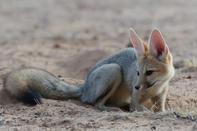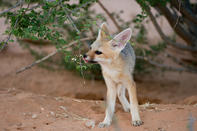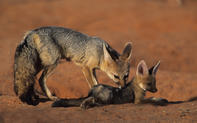With an adult length of 86 to 97 cm and weight of 2,5 kg to 4 kg, the Cape Fox (Vulpus chama), also known as the Silver Fox, is one of the smallest canid species in South Africa.

It is a protected species that mainly occupies open country, such as grassland, grassland with scattered thickets and lightly wooded areas, particularly in the dry Karoo regions, the Kalahari and the fringes of the Namib Desert.
The Cape fox have also been recorded in the Kimberley Thorn Bushveld, Eastern Mixed Kama Karoo and Dry Sandy Highveld Grassland, as well as the fynbos biome of the Western Cape, which has higher precipitation levels and denser vegetation. They tend to avoid areas dominated by Black-backed Jackals (Canis mesomelas).
They usually mate for life, with the male and female forming pairs in spring, and their pups born about 52 days later, in early summer, around September November. They have however also been known to produce litters as late as December. While they normally have one litter per year, there have been incidents where two litters have been recorded per year.
Litters usually consist of three to four pups, with the males providing for the females during the first two weeks after giving birth. The pups start foraging at four months of age and become independent by the time they are five months old. They are sexually mature from nine months of age.
Killing and Feeding Pattern

They are primarily nocturnal, but most active in the cooler daylight hours. The Cape fox may be found alone or in pairs, but hunt on their own. They are not very territorial, with hunting ranges covering from three to thirty square kilometres.
The Predator Management Forum's manual, states that it is rare for Cape foxes to cause stock losses, since they primarily prey on small animals, such as insects, birds, reptiles, rodents and carrion. If they attack livestock, it usually is new-born lambs of up to four days old that are targeted.
Under such circumstances, they will only make one kill per event and usually go for the throat or the head of the prey. Small tooth marks may be left on the neck, shoulder or rump of the carcass, but there won’t be any claw marks and the carcass would not have been dragged.
When feeding, they usually make a small opening at the flank of the animal and then only eat the heart, milk stomach (abomasum), soft hind leg or a combination of these. The tips of the ribs are sometimes eaten, but no bones. On rare occasions, when a group of foxes feed on a carcass, the buttocks will be eaten. The foxes usually return to a kill. The tracks are oblong shaped and have nail marks like dog tracks.
Management
